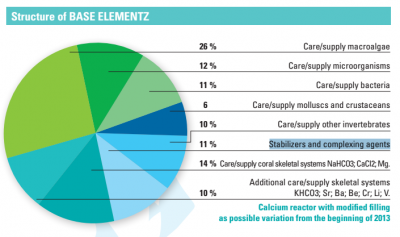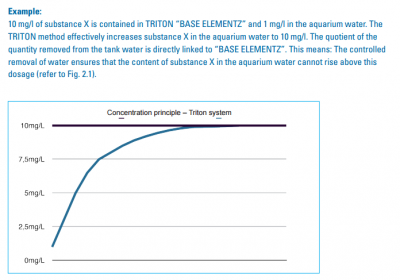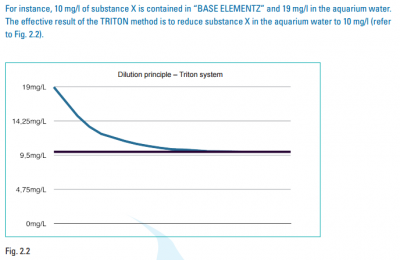- Joined
- Jan 11, 2014
- Messages
- 775
- Reaction score
- 575
I spend a lot of time talking to reefers about Triton so I figured why not share some thoughts on the theories behind Triton with you all here. Many of these thoughts are my own after working with the wonderful products and method for several years now.
Triton and nutrients- Regarding the filtration component that is triton- one would setup the system to include a large algae filter, first inline from the output of the overflow box, followed by the skimmer and fluidized reactor section followed last by the section housing the return pump. Nice and simple.
I would use a very small amount of GFO and keep the po4 levels on the low side while the tank is maturing. Think of your food as phosphate and adjust the amounts you feed to control the level of po4 in the tank while using only a small and consistent amount of gfo to assist in its removal. The use of a quality gfo like Rowa Phos will possibly prevent the introduction of less stable forms of iron and other nasties from contaminating the water chemistry. Using a lot of gfo then feeding heavier to maintain slightly elevated levels of po4 will be tough to balance. Too much power on either side of the equation. Triton aims to keep things simple by frontloading the system with nutrients in the form of food then letting nature process, breakdown and recycle the waste as a form of needed energy. Once we have a well oiled system in place with the right macro algae, bacteria and a stable population of animals in the tank we can ease up on other forms of maintenance like water changes and the use of micron socks until there is arguably no difference if using them or not. The food is eaten by the fish and coral, the extra making its way into the algae filter where it is further broken down by physical forces, bacteria and the algae. Bacteria coats the food particles and detritus and if these make it past the skimmer and into the return pump, then they are blasted back into the display tank to be hopefully fed to the corals they come in contact with. On the backend of this "system" is the small amount of carbon and gfo keeping things from getting too far out of hand should something go awry with the system. These should not be viewed as the reason why a triton tank is successful. The success comes from mature natural processes.
I think of a new triton tank as a bicycle starting from a dead stop. There is a series of training wheels that get stripped away in layers allowing the system to gain speed as it wobbles less, sheds weight and straightens out. (weight is maintenance practices for this analogy) First thing to go is the micron socks, then the detritus siphoning from the sump and display tank, then the water changes and finally the heavier use of gfo and water testing. Of course nature doesn't always work in predictable ways and there are many variables that affect the outcome of a given system but in theory this is how a triton tank could mature. One can expect to see some cyano, maybe some hair algae in the display, some diatoms, etc as the tank goes through its maturing cycles. Don't be discouraged. There isn't a method out there that has zero hiccups. The idea is to remain calm, believe in the system you have created and offer input to it where needed.
The goal, and I have seen this on many amazing Triton tanks, is to create a system that achieves success by focusing on stability by way of minimizing variables. This is key. By using only the essential components of the tried and true sps dominated reef tank can one create a system that is largely replicable by the masses. Sure people can and are encouraged to tweak their individual system to squeeze the most horsepower out of it but the method can only be such if it is stripped down to a common denominator of working parts. I think of the algae bed as the huge suspension system of the tank. It is there to absorb most things you can throw at it. If an auto-feeder malfunctions or an unexplained coral die-off happens it is there to assist. It can expand and convert those nutrients into sugars for the corals in real time. If there is a nutrient drought occuring in the tank then the algae growth will slow down and even possibly die off a bit releasing some needed nutrients into the system. It may not be as fast acting as a well running bio pellet reactor but I feel it sure is more forgiving than the latter in the event of a filter mishap.
Triton and dosing: When people receive their ICP tests and see how certain levels have drifted pretty far out of whack they often contact me to help get things back inline. Without knocking any method or product it is quite logical to think that the less we do in terms of dosing, water exchanging, etc the less potential for drifts in water chemistry from NSW levels. Working hard with them to get things back inline, once they do they of course want to do everything in their power to keep things good (green on the ICP test)
This is where using something like the Base Elementz comes into play. It is a four part mix of major and minor ions that gets dosed throughout the day (typically by a precision doser like DOS) to replenish those ions lost via the systems filter and animal components. It is formulated to work with a triton system in that certain traces are spiked in the mix knowing that things like carbon, the algae bed and the skimmer will be removing them. Since all four parts are dosed exactly the same amount (enough to maintain the alkalinity at 8dkh), the ionic balance is largely maintained. No other form of regular mineral dosing is needed. Just small corrections should be done once things are stable. Water changes, calcium reactors, kalkwasser dosing, etc are all redundant and will most likely throw off the balance and are strongly not recommended when using the Base Elementz. Since every system is different, each system will start to slowly shift away from ionic balance as the minerals are removed from a given system. This shift away from balance should be less than in a typical reef tank where typically just the calcium and alkalinity are dosed daily and the other minerals dosed when they are felt like or tested for typically with hobby kits. Routine water changes will replenish lost ions as well but you can see how this is a gross way of replacing ions that are lost constantly throughout every day. This is the opposite of riding that wave or chemical stability that is so present on an actual coral reef. At least triton comes close by dosing things all day long. The only thing better would be to exchange water constantly from a known, high quality trusted saltwater source. If you were to exchange enough water constantly to maintain alkalinity then you would also arguably be replenishing most if not all of the other needed ions as well in a most balanced formula. The daily or constant water change cannot be knocked aside from its largely impractical appeal.
I will be setting up my 1200 gallon reef tank at home in the next few weeks and will share the progress pics here with you all. It will be a super simple Triton setup. Thanks for reading!
Triton and nutrients- Regarding the filtration component that is triton- one would setup the system to include a large algae filter, first inline from the output of the overflow box, followed by the skimmer and fluidized reactor section followed last by the section housing the return pump. Nice and simple.
I would use a very small amount of GFO and keep the po4 levels on the low side while the tank is maturing. Think of your food as phosphate and adjust the amounts you feed to control the level of po4 in the tank while using only a small and consistent amount of gfo to assist in its removal. The use of a quality gfo like Rowa Phos will possibly prevent the introduction of less stable forms of iron and other nasties from contaminating the water chemistry. Using a lot of gfo then feeding heavier to maintain slightly elevated levels of po4 will be tough to balance. Too much power on either side of the equation. Triton aims to keep things simple by frontloading the system with nutrients in the form of food then letting nature process, breakdown and recycle the waste as a form of needed energy. Once we have a well oiled system in place with the right macro algae, bacteria and a stable population of animals in the tank we can ease up on other forms of maintenance like water changes and the use of micron socks until there is arguably no difference if using them or not. The food is eaten by the fish and coral, the extra making its way into the algae filter where it is further broken down by physical forces, bacteria and the algae. Bacteria coats the food particles and detritus and if these make it past the skimmer and into the return pump, then they are blasted back into the display tank to be hopefully fed to the corals they come in contact with. On the backend of this "system" is the small amount of carbon and gfo keeping things from getting too far out of hand should something go awry with the system. These should not be viewed as the reason why a triton tank is successful. The success comes from mature natural processes.
I think of a new triton tank as a bicycle starting from a dead stop. There is a series of training wheels that get stripped away in layers allowing the system to gain speed as it wobbles less, sheds weight and straightens out. (weight is maintenance practices for this analogy) First thing to go is the micron socks, then the detritus siphoning from the sump and display tank, then the water changes and finally the heavier use of gfo and water testing. Of course nature doesn't always work in predictable ways and there are many variables that affect the outcome of a given system but in theory this is how a triton tank could mature. One can expect to see some cyano, maybe some hair algae in the display, some diatoms, etc as the tank goes through its maturing cycles. Don't be discouraged. There isn't a method out there that has zero hiccups. The idea is to remain calm, believe in the system you have created and offer input to it where needed.
The goal, and I have seen this on many amazing Triton tanks, is to create a system that achieves success by focusing on stability by way of minimizing variables. This is key. By using only the essential components of the tried and true sps dominated reef tank can one create a system that is largely replicable by the masses. Sure people can and are encouraged to tweak their individual system to squeeze the most horsepower out of it but the method can only be such if it is stripped down to a common denominator of working parts. I think of the algae bed as the huge suspension system of the tank. It is there to absorb most things you can throw at it. If an auto-feeder malfunctions or an unexplained coral die-off happens it is there to assist. It can expand and convert those nutrients into sugars for the corals in real time. If there is a nutrient drought occuring in the tank then the algae growth will slow down and even possibly die off a bit releasing some needed nutrients into the system. It may not be as fast acting as a well running bio pellet reactor but I feel it sure is more forgiving than the latter in the event of a filter mishap.
Triton and dosing: When people receive their ICP tests and see how certain levels have drifted pretty far out of whack they often contact me to help get things back inline. Without knocking any method or product it is quite logical to think that the less we do in terms of dosing, water exchanging, etc the less potential for drifts in water chemistry from NSW levels. Working hard with them to get things back inline, once they do they of course want to do everything in their power to keep things good (green on the ICP test)
This is where using something like the Base Elementz comes into play. It is a four part mix of major and minor ions that gets dosed throughout the day (typically by a precision doser like DOS) to replenish those ions lost via the systems filter and animal components. It is formulated to work with a triton system in that certain traces are spiked in the mix knowing that things like carbon, the algae bed and the skimmer will be removing them. Since all four parts are dosed exactly the same amount (enough to maintain the alkalinity at 8dkh), the ionic balance is largely maintained. No other form of regular mineral dosing is needed. Just small corrections should be done once things are stable. Water changes, calcium reactors, kalkwasser dosing, etc are all redundant and will most likely throw off the balance and are strongly not recommended when using the Base Elementz. Since every system is different, each system will start to slowly shift away from ionic balance as the minerals are removed from a given system. This shift away from balance should be less than in a typical reef tank where typically just the calcium and alkalinity are dosed daily and the other minerals dosed when they are felt like or tested for typically with hobby kits. Routine water changes will replenish lost ions as well but you can see how this is a gross way of replacing ions that are lost constantly throughout every day. This is the opposite of riding that wave or chemical stability that is so present on an actual coral reef. At least triton comes close by dosing things all day long. The only thing better would be to exchange water constantly from a known, high quality trusted saltwater source. If you were to exchange enough water constantly to maintain alkalinity then you would also arguably be replenishing most if not all of the other needed ions as well in a most balanced formula. The daily or constant water change cannot be knocked aside from its largely impractical appeal.
I will be setting up my 1200 gallon reef tank at home in the next few weeks and will share the progress pics here with you all. It will be a super simple Triton setup. Thanks for reading!













